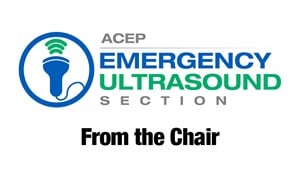
Ask the Expert: Ultrasound Transducer Disinfection - What do ACEP’s New Guidelines Mean for My ED?
ACEP approved the policy statement “Guideline for Ultrasound Transducer Cleaning and Disinfection” in June 2018 that applies to ultrasound probe cleaning in your emergency department. The recent guideline was intended to address an overreach of transducer disinfection guidelines that were not backed by sufficient evidence and to ensure that point-of-care ultrasound (POCUS) programs are sustainable. Specifically, it clarifies that the use of probe covers and low-level disinfection for external transducers (ie, curvilinear, phased-array or linear probes) on non-intact skin does not have increased infection risk and therefore does not require high-level disinfection.
The guideline stratifies a hierarchy of disinfection levels based on use and encountered pathogens, as well as probe cover use to protect against pathogens. Additionally, it highlights the difference between sterile and non-sterile gel. Sterile gel should be used when infection is a concern, including use for cutaneous puncture and on non-intact skin or near fresh surgical sites. It specifies categories for levels of cleaning and disinfection, with an emphasis on an initial manual cleaning prior to disinfection. Manual cleaning is accomplished by removal of any visible soil, including inorganic (eg, gel) or organic (eg, blood) material, by physical wiping or use of soap and water. Disinfection describes a process that eliminates many or all pathogenic microorganisms and is either low- or high-level:
- Low-level disinfection is accomplished with quaternary ammonia sprays or wipes, which destroys most bacteria, some viruses and some fungi.
- High-level disinfection is accomplished by chemical sterilants or germicides and removes all microorganisms except for bacterial spores.
In practice, transducer type and use will mandate if a protective barrier is needed and which level of disinfection is required:
- Transducers used on clean intact skin require low-level cleaning between uses.
- Transducers used on dirty or non-intact skin should be covered with a single use probe cover, and then cleaned with low-level disinfection between uses.
- Transducers used for percutaneous procedures (eg, vascular access, paracentesis, arthrocentesis, regional anesthesia) should be covered with a single use sterile probe cover during the procedure, and then cleaned with low-level disinfection between uses. The guideline notes that sterile adhesive film dressings (eg, tegaderm) may be considered a barrier and is effective, but referral to manufacturer recommendations is warranted.
- Internal transducers, including endocavitary, transvaginal, and transesophageal probes) should be covered with single-use probe cover and then undergo high-level disinfection between uses. Institutional high-level disinfection procedures and workflow should be developed.
In summary, ACEP’s Guideline for Ultrasound Transducer Cleaning and Disinfection clarifies when probe covers are needed, sterile gel should be used, and the required level of disinfection. The Clinical Ultrasound Accreditation Program (CUAP) ensures that accredited programs demonstrate quality and safety processes and can assist departments to ensure appropriate infection control cleaning standards are in place that meet the ACEP ultrasound guidelines.
Scott Kurpiel MD, MBA, FACEP
Secretary, Clinical Ultrasound Accreditation Program (CUAP)



